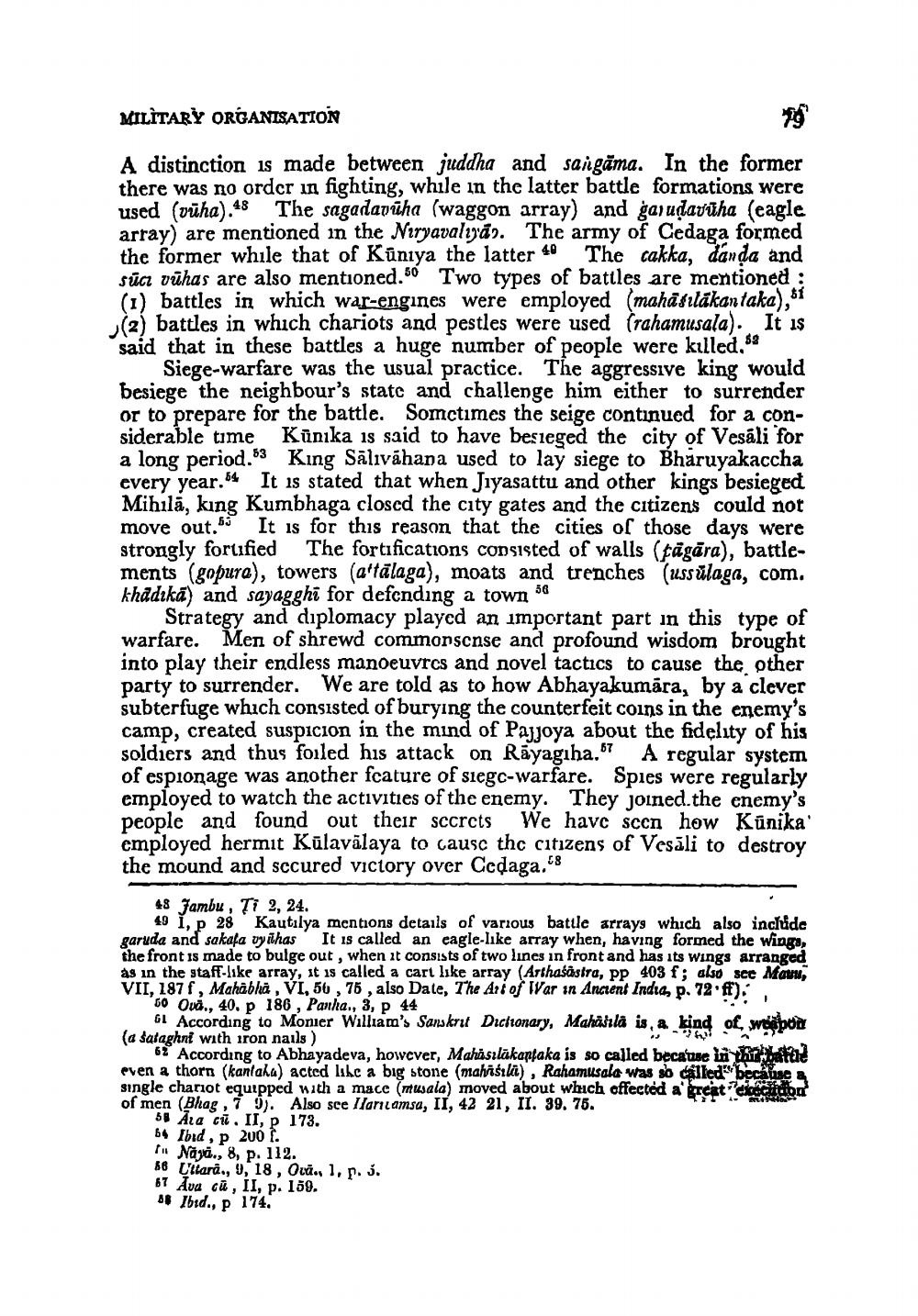________________
MILITARY ORGANISATION
A distinction is made between juddha and saigāma. In the former there was no order in fighting, while in the latter battle formations were used (Dūha).48 The sagadaviha (waggon array) and garudavūha (eagle array) are mentioned in the Nuryavaligā). The army of Cedaga formed the former while that of Kuniya the latter 40 The cakka, danda and sūc vũhas are also mentioned. Two types of battles are mentioned : (1) battles in which war-engines were employed (mahasıläkantaka), 51 (2) battles in which chariots and pestles were used (rahamusala). It is said that in these battles a huge number of people were killed, 52
Siege-warfare was the usual practice. The aggressive king would besiege the neighbour's state and challenge him either to surrender or to prepare for the battle. Somctimes the seige continued for a considerable time Kūnika is said to have besieged the city of Vesāli for a long period.63 King Sälivāhana used to lay siege to Bharuyakaccha every year. It is stated that when Jiyasattu and other kings besieged Mihila, king Kumbhaga closed the city gates and the citizens could not move out. It is for this reason that the cities of those days were strongly fortified The fortifications consisted of walls (tāgāra), battlements (gopura), towers (aftalaga), moats and trenches (ussülaga, com. khádıkā) and sayagghi for defending a town 58
Strategy and diplomacy played an important part in this type of warfare. Men of shrewd commonscnse and profound wisdom brought into play their endless manoeuvres and novel tactics to cause the other party to surrender. We are told as to how Abhayakumāra, by a clever subterfuge which consisted of burying the counterfeit coins in the enemy's camp, created suspicion in the mind of Pajjoya about the fidelity of his soldiers and thus foiled his attack on Rāyagıha.67 A regular system of espionage was another fcature of siegc-warfare. Spies were regularly employed to watch the activities of the enemy. They joined the enemy's people and found out their sccrcts We have seen how Kūnika employed hermit Kūlavālaya to causc thc citizens of Vesāli to destroy the mound and sccured victory over Cedaga."
48 Jambu , TI 2, 24.
49 I, p 28 Kautilya mentions details of various battle array, which also inchide garuda and sakafa vyithas It is called an eagle-like array when, having formed the wings, the front is made to bulge out, when it consists of two lines in front and has its wings arranged as in the staff-like array, it is called a cart like array (Arthašāstra, pp 403 f; also see Matu, VII, 187f, Mahābhā , VI, 56, 76, also Date, The Art of IVar in Ancient India, p. 72.ff).
60 Ová., 40. p 186, Panha., 3, P 44
6. According to Monier William's Sanskrut Dictionary, Maharla is, a kind of weapon (a sataghni with iron nails )
67 According to Abhayadeva, however, Mahasılākaptaka is so called because la Ribattre even a thorn (kanlaha) acted like a big stone (mahaśla), Rahamusala was so called because a single chariot equipped with a mace (musala) moved about whuch offected a krcate cition of men (Bhag, 7 9). Also see Ilaritamsa, II, 42 21, II. 39. 75.
58 Ala cit. II, p. 173. 64 Ibid, p 200 1. tu Naga., 8, p. 112. 56 Uttara., 9, 18, Ovā. 1, p. j. 67 Ava cū, II, p. 159. 48 Ibid., p 174.




